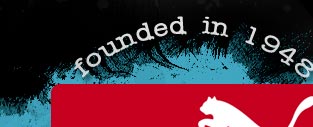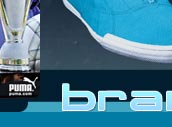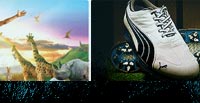60 years of PUMA – 60 years of international football
sponsorship
 Since
its founding, PUMA has been active as an international football sponsor and
equipment supplier to players and teams. As early as 1950, players from the
German national team wear PUMA boots in their first football game after the
Second World War. For the 1958 World Cup held in Sweden, players from the
Brazilian and Swedish teams play wearing football boots from PUMA. In the
following World Cup in Chile in 1962, the Brazilian superstar Pelé wears
PUMA football boots and leads the team to become the World Cup champions and
the “Player of the Tournament”. Four years later, the Portuguese
player Eusébio is a top goal scorer and is also named “Player of
the Tournament”. He is the first to wear the predecessor of today’s
legendary “PUMA KING”, which is later worn by international
football stars like Diego Maradona during subsequent World Cup tournaments (see
attached press release). Top international football players include French
national player Robert Pires, who, in 2002, after one season with Arsenal, is
named “Footballer of the Year” in England. In the same year,
Italian goalkeeper Gianluigi Buffon signs an equipment agreement with PUMA.
During the 2002 World Cup in Japan/Korea, PUMA player El Hadji Diouf is
selected by FIFA to the “All Star Team” team of the World Cup. The
Korean player Ahn Jung-hwan knocks Italy out of the competition with a
“Golden Goal”, thus securing the host country a spot in the
semi-finals. Since
its founding, PUMA has been active as an international football sponsor and
equipment supplier to players and teams. As early as 1950, players from the
German national team wear PUMA boots in their first football game after the
Second World War. For the 1958 World Cup held in Sweden, players from the
Brazilian and Swedish teams play wearing football boots from PUMA. In the
following World Cup in Chile in 1962, the Brazilian superstar Pelé wears
PUMA football boots and leads the team to become the World Cup champions and
the “Player of the Tournament”. Four years later, the Portuguese
player Eusébio is a top goal scorer and is also named “Player of
the Tournament”. He is the first to wear the predecessor of today’s
legendary “PUMA KING”, which is later worn by international
football stars like Diego Maradona during subsequent World Cup tournaments (see
attached press release). Top international football players include French
national player Robert Pires, who, in 2002, after one season with Arsenal, is
named “Footballer of the Year” in England. In the same year,
Italian goalkeeper Gianluigi Buffon signs an equipment agreement with PUMA.
During the 2002 World Cup in Japan/Korea, PUMA player El Hadji Diouf is
selected by FIFA to the “All Star Team” team of the World Cup. The
Korean player Ahn Jung-hwan knocks Italy out of the competition with a
“Golden Goal”, thus securing the host country a spot in the
semi-finals.
 For
the 2006 World Cup, PUMA renews its partnership with football legend
Pelé, who was sponsored by PUMA during his active years as a player and
now advertises for PUMA as its World Cup ambassador. “Over many years, I
have developed a close relationship with the PUMA brand”, Pelé
said at the time. “Now I am happy to collaborate on various projects in
the run-up to the World Cup, together with PUMA”. About PUMA’s
qualities as an equipment supplier, Pelé said: “PUMA and football,
it’s like a big family. Everyone knows that PUMA and football are related
to one another”. In addition to numerous individual players, PUMA has
been successfully equipping and sponsoring teams for many years. Its first
partner in 1950 is the team Spielvereinigung Fürth (current name:
Spielvereinigung Greuther Fürth), which becomes the German football
champion three times in the years 1914, 1926 and 1929. In 1988 and 1993, the
PUMA team SV Werder Bremen wins the German Championship and in 1994 the German
Football Federation Cup. For
the 2006 World Cup, PUMA renews its partnership with football legend
Pelé, who was sponsored by PUMA during his active years as a player and
now advertises for PUMA as its World Cup ambassador. “Over many years, I
have developed a close relationship with the PUMA brand”, Pelé
said at the time. “Now I am happy to collaborate on various projects in
the run-up to the World Cup, together with PUMA”. About PUMA’s
qualities as an equipment supplier, Pelé said: “PUMA and football,
it’s like a big family. Everyone knows that PUMA and football are related
to one another”. In addition to numerous individual players, PUMA has
been successfully equipping and sponsoring teams for many years. Its first
partner in 1950 is the team Spielvereinigung Fürth (current name:
Spielvereinigung Greuther Fürth), which becomes the German football
champion three times in the years 1914, 1926 and 1929. In 1988 and 1993, the
PUMA team SV Werder Bremen wins the German Championship and in 1994 the German
Football Federation Cup.
During the same year, the Argentine team and PUMA partner Velez Sarsfield wins
the World Club Championship in Tokyo with a 2-0 victory over A.C. Milan. Its
winning streak is still going strong even one year later. Real Saragossa wins
the UEFA Cup Winner’s Cup wearing the PUMA shirt. In 1995, the PUMA team
Atlético Madrid comes first in the Spanish premier league and wins the
Spanish League Cup. The Italian team S. S. Lazio Rom also scores a major
victory in 1999 when it wins the UEFA Cup Winner’s Cup and then, in the
following year, winning the league in Italy, the League Cup and the
Italy’s Super Cup. PUMA has sponsored the Italian national team since
2002. In 2004, it introduces an innovative team shirt in collaboration with the
designer and creative director of the ITALIA Collection, Neil Barrett. The 2006
World Cup held in Germany is a high point of the decade-long string of
successes for PUMA. As a leading sponsor and equipment supplier, PUMA supplies
12 of the 32 participating teams: Italy, the Czech Republic, Poland,
Switzerland, Paraguay, Saudi Arabia, Iran as well as the five African teams,
Tunisia, Ghana, Ivory Coast, Angola and Togo. PUMA thus achieves a brand
presence in 56 percent of all games during the World Cup and is the most
heavily represented brand compared to the competition. Moreover, for the first
time in the company's history, a team sponsored by PUMA wins the World Cup
Championship. Italy’s Squadra Azzurra beats France 5-3 in a penalty
shoot-out on July 9, 2006 in the World Cup final held in Berlin, becoming the
World champions for the fourth time. In 2007, the PUMA team VfB Stuttgart wins
the German Championship.
 In
its anniversary year of 2008, PUMA once again shows its strong position as a
football equipment provider by having five teams represent it in the 2008
European Football Championship tournament. In addition to World Cup champions
Italy, Poland, the Czech Republic as well as host countries Switzerland and
Austria appear wearing the company’s trademark cat on their shirts. For
many years, PUMA has also been a leading sports equipment supplier and sponsor
for African football and has shown that its commitment to the African Continent
is just as ambitious as the passion of Africans for football itself. In 1997,
PUMA signs an equipment supply agreement with the Cameroon football association
FECAFOOT and becomes the equipment supplier and sponsor for its national team.
The Cameroon team wins the 2000 African Cup of Nations during a penalty
shoot-out against Lagos. Six months later, the team wins the country’s
first-ever gold medal at the Olympic Summer Games in Sydney, Australia. PUMA
supports the success of the Cameroon team with an advertising campaign for the
2002 World Cup, which focuses on the national team. During the same year, the
team of “indomitable lions” once again wins the Africa Cup of
Nations. The equipment supply agreement with PUMA is extended in 2006. For the
2006 World Cup, PUMA begins a cooperation with the campaign UNITED FOR AFRICA.
The goal of the cooperation is to use original advertising spots to draw
attention to UNITED FOR AFRICA and to generate donations for 30 active aid
organizations in Africa. PUMA creates a charity collection exclusively for this
partnership. From the sales price of each collection item, PUMA donates an
amount, transparently listed for the customer to see, to UNITED FOR AFRICA. The
highlight of the cooperation is the UNITED FOR AFRICA streetcar, a concept
developed by both partners. Equipped with special informational and interaction
options, the streetcar drives through Berlin advertising for the campaign. Both
in the streetcars as well as in the Berlin Café Moscow, PUMA’s
football headquarters for the World Cup, there are numerous events held with
prominent artists and athletes. In
its anniversary year of 2008, PUMA once again shows its strong position as a
football equipment provider by having five teams represent it in the 2008
European Football Championship tournament. In addition to World Cup champions
Italy, Poland, the Czech Republic as well as host countries Switzerland and
Austria appear wearing the company’s trademark cat on their shirts. For
many years, PUMA has also been a leading sports equipment supplier and sponsor
for African football and has shown that its commitment to the African Continent
is just as ambitious as the passion of Africans for football itself. In 1997,
PUMA signs an equipment supply agreement with the Cameroon football association
FECAFOOT and becomes the equipment supplier and sponsor for its national team.
The Cameroon team wins the 2000 African Cup of Nations during a penalty
shoot-out against Lagos. Six months later, the team wins the country’s
first-ever gold medal at the Olympic Summer Games in Sydney, Australia. PUMA
supports the success of the Cameroon team with an advertising campaign for the
2002 World Cup, which focuses on the national team. During the same year, the
team of “indomitable lions” once again wins the Africa Cup of
Nations. The equipment supply agreement with PUMA is extended in 2006. For the
2006 World Cup, PUMA begins a cooperation with the campaign UNITED FOR AFRICA.
The goal of the cooperation is to use original advertising spots to draw
attention to UNITED FOR AFRICA and to generate donations for 30 active aid
organizations in Africa. PUMA creates a charity collection exclusively for this
partnership. From the sales price of each collection item, PUMA donates an
amount, transparently listed for the customer to see, to UNITED FOR AFRICA. The
highlight of the cooperation is the UNITED FOR AFRICA streetcar, a concept
developed by both partners. Equipped with special informational and interaction
options, the streetcar drives through Berlin advertising for the campaign. Both
in the streetcars as well as in the Berlin Café Moscow, PUMA’s
football headquarters for the World Cup, there are numerous events held with
prominent artists and athletes.
In 2007, PUMA once again expands its portfolio as an equipment supplier and
sponsor of African teams. It becomes partners with the Moroccan and Namibian
national football associations. Furthermore, PUMA supports the global Peace One
Day campaign with a new and exclusive football collection. The joint, long-term
goal is to establish a day of cease-fire and freedom from violence worldwide.
The UN General Assembly chooses September 21 as this International Day of
Peace. The launch of the Peace One Day Collection is held in January 2008
during the Africa Cup of Nations football tournament.
|














